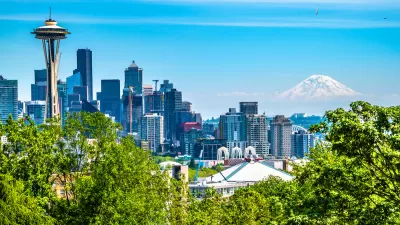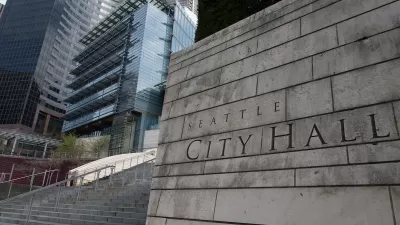Seattle trails international peer cities in its social housing stock, but there are steps city leaders can take to produce more units and increase affordability.

Doug Trumm reports on Seattle's limited progress in creating more social housing, defined as "several forms of affordable housing including public housing, nonprofit housing, and rent-restricted homes in market-rate buildings offered via incentive programs like inclusionary zoning." Trumm points to peer cities around the world where social housing is a major part of housing policy. Singapore's social housing comprises 80% of housing stock; in Vienna, that number is 60%. Famously expensive Paris is on track to have 30% social housing by 2030. In Seattle, social housing comprises just 8.6% of housing stock, a number not projected to increase much.
Building more social housing, Trumm argues, " would combat displacement and shrink commutes for working class people, who keep the city functioning and culturally vibrant," and "engender mixed-income neighborhoods rather than Seattle slipping into a one-class city of the rich." This sentiment is echoed by Paris mayor Anne Hidalgo, whose statement that "everyone should have the possibility to live in Paris" has guided city policy during her administration.
According to Trumm, Seattle has the opportunity to build more social housing through the Seattle Housing Levy, the city's Mandatory Housing Affordability (MHA) program, and a variety of tax programs aimed at promoting housing density and producing revenue for housing projects. "The benefits of social housing are significant and setting an ambitious social housing target isn’t about bragging rights. It’s about making Seattle a better city and increasing quality of life for all people, not just the rich." Once freed from excessive rent burdens, Trumm writes, "working class folks would pump money into the economy, invest in education, business ventures, cultural creation, and their personal wellbeing."
FULL STORY: Growing Social Housing in Seattle

Alabama: Trump Terminates Settlements for Black Communities Harmed By Raw Sewage
Trump deemed the landmark civil rights agreement “illegal DEI and environmental justice policy.”

Study: Maui’s Plan to Convert Vacation Rentals to Long-Term Housing Could Cause Nearly $1 Billion Economic Loss
The plan would reduce visitor accommodation by 25% resulting in 1,900 jobs lost.

Planetizen Federal Action Tracker
A weekly monitor of how Trump’s orders and actions are impacting planners and planning in America.

This Toronto Suburb Has More Bus Riders Than Columbus, Ohio
Brampton, Ontario used gradual improvements in service to prove that if you build it, they will ride.

Paris Bike Boom Leads to Steep Drop in Air Pollution
The French city’s air quality has improved dramatically in the past 20 years, coinciding with a growth in cycling.

Why Housing Costs More to Build in California Than in Texas
Hard costs like labor and materials combined with ‘soft’ costs such as permitting make building in the San Francisco Bay Area almost three times as costly as in Texas cities.
Urban Design for Planners 1: Software Tools
This six-course series explores essential urban design concepts using open source software and equips planners with the tools they need to participate fully in the urban design process.
Planning for Universal Design
Learn the tools for implementing Universal Design in planning regulations.
Smith Gee Studio
Alamo Area Metropolitan Planning Organization
City of Santa Clarita
Institute for Housing and Urban Development Studies (IHS)
City of Grandview
Harvard GSD Executive Education
Toledo-Lucas County Plan Commissions
Salt Lake City
NYU Wagner Graduate School of Public Service





























